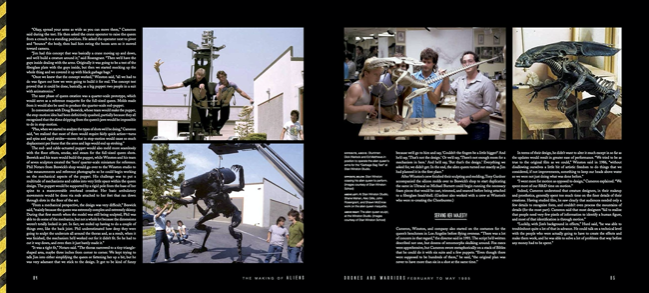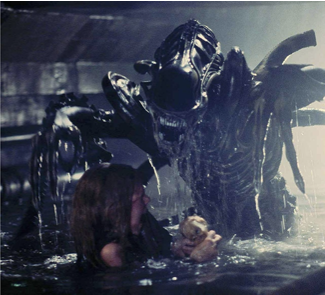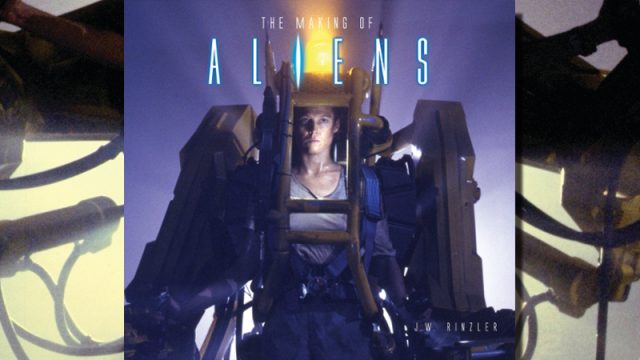What more can be said of James Cameron’s sci-fi blockbuster Aliens — one of the greatest action flicks of all time, featuring, perhaps, cinema’s most famous action heroine; and boasting any number of long-lasting pop cultural staples including the Alien Queen, the military aesthetic, and the various set pieces that have since been replicated in any number of films? As it turns out, quite a bit. To that end, J.W. Rinzler, author of “The Making of Star Wars,” “The Making of The Empire Strikes Back,” “The Making of Planet of the Apes” and “The Making of Alien” now brings us The Making of Aliens, which delves deeper into the intense production of Cameron’s classic film than ever before, even if a lot of the material is regurgitated from those in-depth making of documentaries currently found on the Alien Quadrilogy Blu-ray set.
Click here to purchase Titan Books’ The Making of Aliens!
 Spanning nearly 300 pages and bursting with eye-popping photos, production stills and conceptual artwork, “The Making of Aliens” follows Cameron and then-wife producer Gale Anne Hurd as they traverse the tricky Hollywood landscape to produce a follow-up to Ridley Scott’s 1979 sci-fi shocker.
Spanning nearly 300 pages and bursting with eye-popping photos, production stills and conceptual artwork, “The Making of Aliens” follows Cameron and then-wife producer Gale Anne Hurd as they traverse the tricky Hollywood landscape to produce a follow-up to Ridley Scott’s 1979 sci-fi shocker.
The most interesting aspect brought forward by this new book is the notion that Aliens was produced like a small film on a tiny budget totaling roughly $18.5 million. That figure actually surpasses the budgets to other hits of 1986, including Top Gun ($15M), Crocodile Dundee ($8M AUD), The Karate Kid Part II ($13M) and Back to School ($11M), all of which earned more at the box office, though, considering Scott’s Alien grossed a whopping $203M against a $10M production budget, you’d think the suits at 20th Century Fox would have allotted more cash to Cameron’s ambitious follow-up. (By contrast, Richard Donner’s Superman: The Movie carried a heft $55M price tag making it the most expensive film ever produced to that point.)
Instead, the low budget set up a grueling production that spanned nine months (including postproduction work) and resulted in several firings, a lawsuit by at least one special effects company, and plenty of rifts between the team and its “perfectionist” director. (Although, consensus of Cameron by those involved with the production seems to be he’s a nice guy… just very demanding.) At one point, the production stalled so cast and crew could hash out their issues with Cameron while Hurd and star Sigourney Weaver served as mediators.
The biggest gripes came from Cameron’s intolerance towards the numerous breaks the staff at Pinewood insisted on taking. Indeed, a well-documented account of the famed director’s futile battle to stymy a tea cart from intruding on his production are given even more detail by Rinzler and are fascinating in and of themselves. For Cameron, Aliens represented the turning point of his career. As such, his focus was intense and resolve complete. For everyone else on the production it was just a job; and that lack of synergy led to plenty of bad blood between everyone from the model makers to the main film crew.
Other notes of interest include the casting process. Did you know that Bill Paxton was originally about to join Police Academy 2 when he got the call to do Aliens for much less? Or that the actor made up the famed “We’re on an express elevator to Hell! Going down!” line right before cameras rolled? Or that Fox decided to push most of its marketing dollars towards the long-forgotten SpaceCamp (which went on to gross less than $10M at the box office), mainly due to Aliens’ excessive 2 hour+ run time? Or that, upon completion of his script and deal to direct Aliens, Cameron learned that Fox had yet to approach Weaver to star in the pic and instead wanted Cameron to retool the film for a male lead? Or that Cameron bumped into Ridley Scott during the production (Scott was working on Legend at the time) and awkwardly sidestepped any mention of Aliens?
 “The Making of Aliens” contains such unique details, plus a look at Cameron’s early drafts of the screenplay and his concept drawings for the Queen that convinced Stan Winston to jump aboard the production. (Another tidbit: Cameron was developing Terminator, writing Rambo: First Blood Part II and Alien II, as it was then known, in unison and set up separate desks to work on each project. The man is a machine.) There are also interesting notes regarding some of the uniquely designed special effects used to cheat the production cost, which feels a little like a magician revealing his tricks. Once you see Cameron’s sleight of hand, it’s hard not to feel simultaneously impressed by the creativity (a forced perspective shot of the Alien Hive, for instance, is mind blowing) and let down by the B-movie crassness. Readers will certainly come to appreciate Cameron’s ability to turn a feeble budget into an A-grade motion picture that still holds up well to this day, and not just in terms of its astonishing visuals.
“The Making of Aliens” contains such unique details, plus a look at Cameron’s early drafts of the screenplay and his concept drawings for the Queen that convinced Stan Winston to jump aboard the production. (Another tidbit: Cameron was developing Terminator, writing Rambo: First Blood Part II and Alien II, as it was then known, in unison and set up separate desks to work on each project. The man is a machine.) There are also interesting notes regarding some of the uniquely designed special effects used to cheat the production cost, which feels a little like a magician revealing his tricks. Once you see Cameron’s sleight of hand, it’s hard not to feel simultaneously impressed by the creativity (a forced perspective shot of the Alien Hive, for instance, is mind blowing) and let down by the B-movie crassness. Readers will certainly come to appreciate Cameron’s ability to turn a feeble budget into an A-grade motion picture that still holds up well to this day, and not just in terms of its astonishing visuals.
RELATED: CS Soapbox: Did Alien 3 Beget Riddick?
There’s also a lengthy section devoted to the film’s marketing campaign that initially left viewers confused — it’s title, in particular, led people to believe it was just more of the original, for some reason — but eventually found traction with the masses, though it was word-of-mouth that ultimately propelled Aliens to over $206M worldwide. (As a side, a majority of film critics at the time, including Roger Ebert, weren’t fond of the flick and felt it was too intense; and too much of a departure from Scott’s “artsy” flick.)
All told, “The Making of Aliens” offers a fascinating look at one of our greatest films and makes for an easy weekend read. That it lacks the drama of Rinzler’s previous deep dives is mainly due to the relatively straight forwardness of the production. Aliens was an intense experience for all, including bodybuilder Jenette Goldstein, who played the tough-as-nails Vasquez and became good friends with actor Mark Rolston (Pvt. Drake) due to long hours of sitting on stools holding their 40 pound M56 Smart Guns — other actors like Paxton and Paul Reiser (Carter Burke) were free to run amok on set, while Michael Biehn (Hicks) did indeed get caught sleeping in-between takes leading Weaver to quip, “There’s my leading man” — but, mostly, many were happy with the final pic and the experience. As such, the enjoyment from “The Making of Aliens: comes from gleaning new insights into the production that cast a whole new light on specific scenes and characters.
Funny enough, had Aliens merely succeeded many in the industry would have shrugged, blamed Cameron and moved on. That the film went on to become one of the all-time classic action adventure films is a damned miracle and a testament to Cameron’s extraordinary abilities as a film director.










